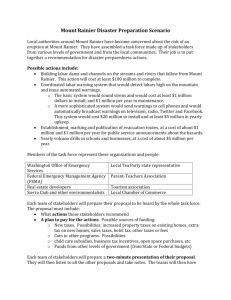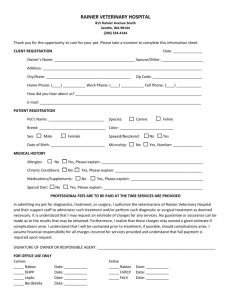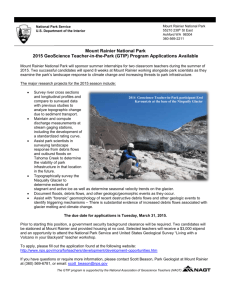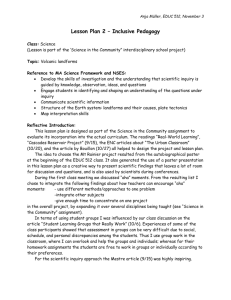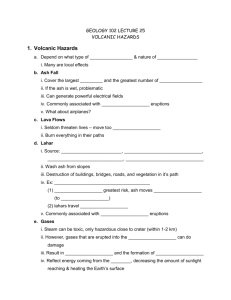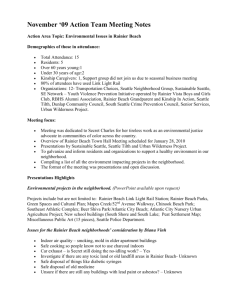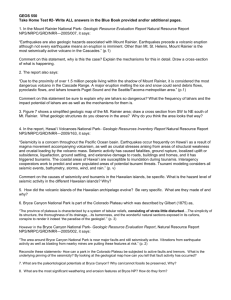Life in 98118
advertisement
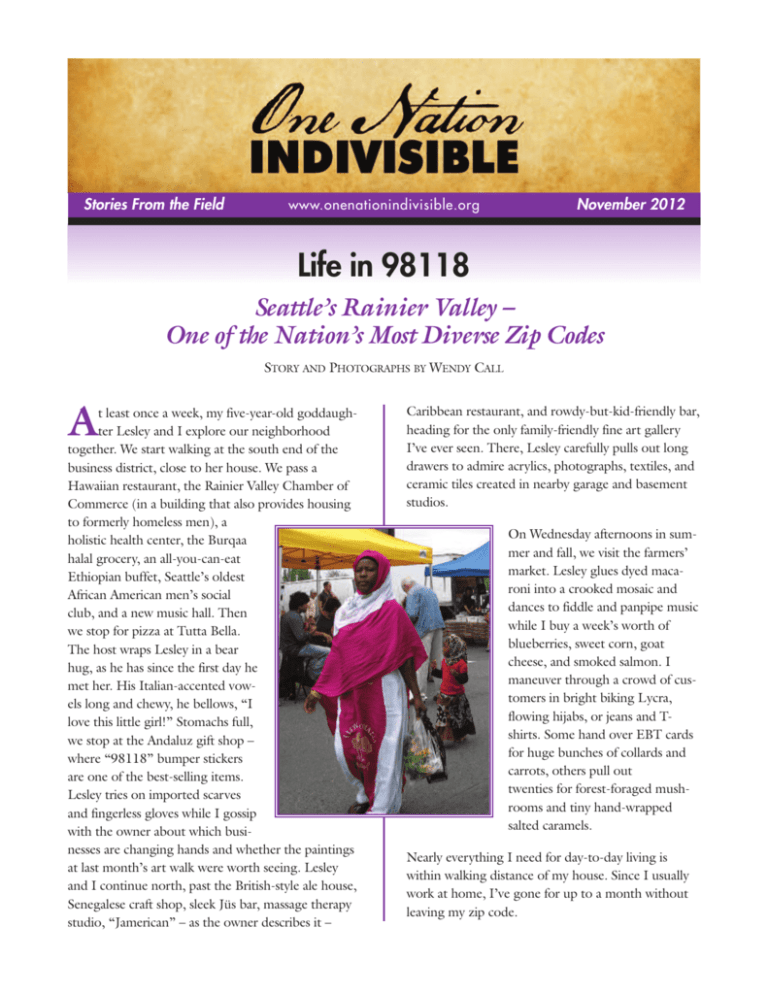
Stories From the Field www.onenationindivisible.org November 2012 Life in 98118 Seattle’s Rainier Valley – One of the Nation’s Most Diverse Zip Codes STORY AND PHOTOGRAPHS BY WENDY CALL A t least once a week, my five-year-old goddaughter Lesley and I explore our neighborhood together. We start walking at the south end of the business district, close to her house. We pass a Hawaiian restaurant, the Rainier Valley Chamber of Commerce (in a building that also provides housing to formerly homeless men), a holistic health center, the Burqaa halal grocery, an all-you-can-eat Ethiopian buffet, Seattle’s oldest African American men’s social club, and a new music hall. Then we stop for pizza at Tutta Bella. The host wraps Lesley in a bear hug, as he has since the first day he met her. His Italian-accented vowels long and chewy, he bellows, “I love this little girl!” Stomachs full, we stop at the Andaluz gift shop – where “98118” bumper stickers are one of the best-selling items. Lesley tries on imported scarves and fingerless gloves while I gossip with the owner about which businesses are changing hands and whether the paintings at last month’s art walk were worth seeing. Lesley and I continue north, past the British-style ale house, Senegalese craft shop, sleek Jüs bar, massage therapy studio, “Jamerican” – as the owner describes it – Caribbean restaurant, and rowdy-but-kid-friendly bar, heading for the only family-friendly fine art gallery I’ve ever seen. There, Lesley carefully pulls out long drawers to admire acrylics, photographs, textiles, and ceramic tiles created in nearby garage and basement studios. On Wednesday afternoons in summer and fall, we visit the farmers’ market. Lesley glues dyed macaroni into a crooked mosaic and dances to fiddle and panpipe music while I buy a week’s worth of blueberries, sweet corn, goat cheese, and smoked salmon. I maneuver through a crowd of customers in bright biking Lycra, flowing hijabs, or jeans and Tshirts. Some hand over EBT cards for huge bunches of collards and carrots, others pull out twenties for forest-foraged mushrooms and tiny hand-wrapped salted caramels. Nearly everything I need for day-to-day living is within walking distance of my house. Since I usually work at home, I’ve gone for up to a month without leaving my zip code. Stories From the Field One Nation Indivisible November 2012 On the way home, Lesley and I stop at a playground grounds. Our relationship with Jaime, Elena, and one block from my house. I step to the sidelines with Lesley isn’t just the result of being neighbors, of the adults. Lesley recruits kids for hidecourse. I lived for several years in and-seek. Over the traffic drone on Elena’s home state in Mexico. We share …adults call to their Rainier Avenue, adults call to their chilinterests like gardening and cooking. children in Amharic, dren in Amharic, Chinese, English, But in much of the United States, our Chinese, English, Khmer, Korean, Somali, Spanish, friendship wouldn’t have happened at Tagalog, Tigrinya, and Vietnamese. all, because we would have never met. Khmer, Korean, Sometimes, the only English at the Our ties are a direct result of the place Somali, Spanish, playground comes from children speakwe call home: Rainier Valley, in Seattle’s Tagalog, Tigrinya, ing to each other. Like Lesley’s parents, south end. and Vietnamese. I speak to her in Spanish. I have lived in Rainier Valley since 2004 Sometimes, the only My partner, Aram, and I met Lesley’s – the longest I’ve stayed in a single zip English at the playparents, Jaime and Elena, before their code in my life. When I arrived here, at ground comes from daughter was born. They lived across age 35, I’d lived in fourteen towns and children speaking to the street from us, in a house that had cities in nine different states. I settled each other. long been home to a frequently changhere in part because this neighborhood ing group of recent arrivals from reminded me of the cultural and racial Mexico and Guatemala. When Jaime mix of the military enclaves where I and Elena learned that we could speak grew up. I didn’t quite underSpanish they sought out our friendship. stand why people In 2010 my adopted home attracted Over that first year, we shared vegetable national attention. The U.S. Census found our relationseedlings, backyard barbeques, and pots that year found that the 23,000 houseship with Lesley and of winter stew. After Elena became holds of zip code 98118, whose borders pregnant with Lesley, they asked us to her parents to be so are nearly the same as Rainier Valley, be her godparents. interesting, or even spoke 59 different languages. By that strange. Only People often ask me how Aram and I measure – if such a thing can be measrecently have I come became friends with Jaime and Elena. ured – 98118 was one of the most Quite often, they seem perplexed by the diverse zip codes in the United States. to understand that fact that an author and an electrical Even I was surprised. A neighborhood it’s not so common engineer are godparents to the daughin Seattle? Not Chicago? Or New York? for immediate ter of immigrants who clean offices and Both those cities do boast zip codes of neighbors to have hotel rooms for a living. We grew close, high language-diversity: Chicago’s such different I tell them, because we used to live Albany Park (60625), Brooklyn’s backgrounds. across the street from each other. Kensington (11218), and Queens’ Having grown up in the multiracial, Jackson Heights (11372). The list of multiethnic world of U.S. military highly diverse zip codes is short. Even bases, I didn’t quite understand why people found as Rainier Valley reflects the increasing racial, cultural, our relationship with Lesley and her parents to be so and economic diversity of our nation, it remains an outlier in the U.S. and in Seattle for its level of interesting, or even strange. Only recently have I integration. come to understand that it’s not so common for immediate neighbors to have such different back2 Stories From the Field One Nation Indivisible November 2012 I first moved to the Emerald City in 1990, right after My neighborhood is highly diverse in part because college, living in a Central Seattle neighborhood that the rest of Seattle is not. Like so much of the United was home to an almost equal share of African States, the Northwest’s largest city is extremely segreAmericans and whites. Two years later, I left Seattle gated. People of color make up 44 percent of to follow a job to Boston. A dozen Seattle’s overall population but comprise years later, I moved back to Seattle and 69 percent of Rainier Valley’s residents. My neighborhood is found my old neighborhood transThis segregation, of course, was created formed. Three-story mansions had by design. Until the 1960s, titles for highly diverse in part replaced small, worn cottages; most of homes in many Seattle neighborhoods because the rest of the faces were white. In that way, the had covenants that barred ownership by Seattle is not. Like neighborhood had become like much people of African, Asian, or Jewish so much of the of Seattle: Only five U.S. cities have a descent. Typical wording stated: “No United States, the higher percentage of white residents property in said addition shall at any Northwest’s largest than Seattle does. time be sold, conveyed, rented, or leased in whole or in part to any person or percity is extremely So, like many people from my old sons not of the White or Caucasian segregated. neighborhood, I moved south. Rainier race.” That particular covenant included Valley’s six square miles—bounded by all the houses in a large North Seattle Lake Washington to the east, Seattle’s development owned by Bill Boeing—founder of the southern city limit, and Interstates 5 and 90—are aerospace multinational that, ironically, spurred much highly diverse even at the city-block level. That is to of the African American migration to Seattle. A say, many streets in 98118’s ten neighborhoods Supreme Court decision outlawed such restrictive (Brighton, Genesee, Columbia City, racial covenants in 1948, but they conHillman City, Holly Park, Othello, tinued to be used until the Seattle City This segregation, of Pritchard Beach, Rainier Beach, Council banned them in 1968. Such Seward Park, and South Beacon Hill) course, was created by restrictions were far less common in look like mine. My seven immediate Rainier Valley, so generations of immidesign. Until the neighbors are a 98118 microcosm. In grants have come here. 1960s, titles for homes addition to the Spanish-speaking group in many Seattle house where Jaime and Elena once A couple of years after I moved to neighborhoods had lived, my block is home to a young, Rainier Valley, I organized a series of white, professional couple who recently bilingual English-Spanish cultural events. covenants that bought their house from a Filipina I looked for other bilingual writers and barred ownership by widow who had raised her family there; artists to join me and got to know people of African, an African American family who has Felicia Gonzalez, a Cuban-American Asian, or Jewish lived here for 30 years; an African poet who has lived in 98118 since 1996. descent. American master gardener who bought When she first moved to Seattle in 1992, her house 15 years ago; a developmenshe worked at El Centro de la Raza, a tally disabled white woman who has Latino community organization based near Rainier Valley. lived in the same dilapidated home all her life; a Head Start program operated by an AME church; and a Last year, Felicia and several other local artists, writpublic health clinic. ers, and activists founded “Represent! 98118,” a 3 Stories From the Field One Nation Indivisible November 2012 project to record community life through art, capturall. Just a few blocks northeast of my block’s vinyling “what it means to be at home among different sided bungalows, huge houses with views of Lake cultures.” At the cooperatively run Columbia City Washington and the Cascade Mountains sell for more Gallery, “Represent! 98118” than a million dollars. Some of mounted a photography exhibit Rainier Valley’s ridgelines and that recorded “A Day in the waterfronts have only high-end Life of 98118.” One wall disproperties, but most of 98118 played large photographs taken is a low-lying housing hodgeby volunteers on October 5, podge. My block is fairly 2011, one day in the life of a typical: one large, turn-of-thezip code. A local writer snapped last-century farmhouse; a an image of a Somali family handful of 1920s Craftsmans, buying flowers at the farmers’ some of them less than 800 market. An elementary school square feet; several humble, teacher captured a group of her boxy houses built post-World students, heads bowed together War II; and two tall, slim as they worked at a large desk. houses towering over the rest, Along the other wall, a grid of recently squeezed on subdiclose-cropped portraits showed vided lots. This mix fosters those who live and work in economically diverse neighbor98118. The portraits smiled hoods. out onto the street through the A few days before Aram and I gallery’s floor-to-ceiling winbought our Columbia City dows. People walking by house in November 2004, the outside paused to point out Rainier Valley Historical Society their middle-school teacher, post office …most of 98118 is a (RVHS) hosted “Double Exposures,” a worker, musician neighbor, or local low-lying housing then-and-now photographic exhibit. restaurant owner in the images. hodgepodge.… The rooftop peak of our bungalow This mix fosters Felicia says, “Walking down the street appears in one vintage image. When the you see Eritrean teenagers, and the photo was taken in 1925, our house was economically diverse Orthodox community in Seward Park brand new and cable cars ran down the neighborhoods. going to shul, and then you have the center of Rainier Avenue in front of yuppies with strollers in Columbia City. curved-front commercial blocks. The People are living vastly different lives cable-car tracks have long since been but in very close proximity. It happens in 98118 in paved over and the storefronts razed. Our secondways that it doesn’t really happen elsewhere in the story window now looks out over a vast parking lot city.” and homely strip mall: a karaoke bar, furniture showroom, and Chinese banquet hall that hosts many In Rainier Valley, dramatically different housing types Cambodian and Ethiopian wedding celebrations. The exist almost side by side, thanks to Seattle’s famously sense of continuity offered by “Double Exposures” folded topography. Because of Seattle’s many hills appealed to me. Having grown up without a home(even more than San Francisco), properties with town, I liked the idea that I might be able to adopt breathtaking views stand next to lots with no view at one that had strong roots, even if I didn’t. 4 Stories From the Field One Nation Indivisible At the exhibit reception, I met RVHS’s director, Mikala Woodward, and bought a cookbook she had recently edited. In 2002, Mikala had organized high school students to interview their neighbors, transcribe oral histories, and collect family recipes. She tested dozens of recipes: Juneteenth red velvet cake, Ethiopian doro wote stew, sweet Italian pizzelles, and deep-fried Filipino lumpia rolls. Having grown up on lumpia and buñuelos (a sort of Mexican pizzelle) at military-family potlucks, this cookbook helped me feel right at home. November 2012 and begin farms. Mikala and her colleagues knew that few people would read a dense history text, so they wrapped the lessons of Rainier Valley’s past (and present) in food. “Anybody living in Rainier Valley is not in the majority,” says Mikala, who has lived here since 1994. “We all have to get used to people who are different.” One-third of 98118’s residents were born in Washington State, one-third elsewhere in the U.S., and one-third in another country. The Rainier Valley Historical Society has not always embraced the community’s growing diversity. The organization evolved from a largely segregated group, the “Columbia Pioneers,” founded in 1891 by the white settlers who had purchased the first lots platted in Columbia City. Into the 1980s, membership was open only to people who could prove they had fifty years of family history in Rainier Valley. Since the area had been 98 percent white until World War II, this excluded most current residents. In 1993, the “Pioneers” reorganized as a historical society that welcomes all Rainier Valley residents and celebrates our varied histories and backgrounds. Mikala, who directed RVHS until 2009, braided the recipes and interviews with historical context, creating Rainier Valley Food Stories Cookbook: A Culinary History. She considered the cookbook a friendly way to strengthen community, for people to learn more about Rainier Valley’s long history as a home for new immigrants. In the last two decades many Guatemalan, Ethiopian, Eritrean, Mexican, and Somali families have arrived here. Before that, Cambodians, Laotians, and Vietnamese immigrated to 98118. A half century ago, Filipino immigrants and African Americans from the South settled here. And more than a century ago, Italian and Japanese workers came to clear old-growth forests, build roads, 5 Stories From the Field One Nation Indivisible In some ways, those varied backgrounds are a microcosm of the United States. The income distribution of the 23,000 households in 98118 mirrors the nation’s, though we have fewer households in the wealthiest bracket. The median household income is $55,717, about $6,000 more than the national median. As it does at the national level, this median masks extreme inequality. My two-person household (a self-employed writer and a telecommunications engineer) has an income several times that of our goddaughter Lesley’s family of six. November 2012 98118 is lower than it is for Seattle overall. In American cities, crime rates tend to be lower in highly diverse neighborhoods than they are overall in the cities where those neighborhoods are located. Albany Park’s crime rate is lower than Chicago’s city-wide rate; the same is true for Brooklyn’s Kensington and Queens’ Jackson Heights. People tend to look out for one another in the Rainier Valley. We became friends with Lesley’s parents during a period when Aram and I were often traveling. Jaime and Elena watched our house when it was empty and brought over pots of soup after we returned from long trips. In other ways, Rainier Valley does not resemble the rest of the country. A larger share of people who live here did not finish high school and a higher share attended graduate school. In terms of education, Lesley’s parents, my partner Aram, and I represent our neighborhood quite well: one PhD, one master’s degree, an eighth-grade education, and a third-grade education. Rainier Valley’s businesses and nonprofit organizations tend to be While we look differcommunity-oriented, too. With few ent from today’s wealthy residents, it’s not a particularly United States, we lucrative place to open a restaurant or look more like the retail shop. Those who do are usually local residents deeply invested in the country we’re becomneighborhood. In the entire Columbia ing.… By 2050 City business district, there are only two America will look chains: Starbucks and Subway. The more like 98118. The U.S. population is 64 percent Starbucks opened thanks to a 50 perwhite, but only 31 percent of Rainier cent investment from basketball star Valley residents described themselves Magic Johnson. Part of Johnson’s effort that way in the 2010 census. While we look different to bring retail services to urban neighborhoods, the from today’s United States, we look more like the Columbia City Starbucks came after Johnsoncountry we’re becoming. The 2010 census reports Starbucks ventures in Culver City, California and that Rainier Valley’s residents are 26 percent of Harlem. African descent, 32.5 percent of Asian descent, 1.5 percent Native, 9 percent multiracial or “some other Rainier Valley is also home to community organizarace,” and 8 percent Latino. By 2050 America will tions that, as Mikala Woodward puts it, “reach across look more like 98118. One of five U.S. residents will difference.” That is to say, rather than serve a particube an immigrant. Whites will no longer hold a majorlar demographic or self-selected group, they work ity. Barely one third of children living in the United consciously to bring together people of different culStates will be white. We don’t know whether people tures, ages, income levels, or languages. The Rainier will live in neighborhoods as integrated as 98118 in Valley Historical Society is one example; it left behind that future America. Current trends tilt sharply its exclusionary past to become a resource for the against it, but I think they just might be happier if entire community. they do. Even at the age of five, Lesley has benefitted from Rainier Valley organizations that are reaching across They might be safer, too. The overall crime rate difference. She attends an inexpensive summer day (property and personal crime rates combined) in 6 Stories From the Field One Nation Indivisible camp offered by Arts in Motion, a school that enthusiastically fulfills its daunting mission: To provide highquality performing arts education to Rainier Valley residents, “without regard to age, artistic aptitude or ability to pay.” November 2012 same mix of people that lives and works along Rainier Avenue spends weekends enjoying Seward Park’s forest and beach. Mikala Woodward, the local historian, says, “I love that there are big Latino family barbeques, and African kids playing soccer on the field, and everybody, but everybody is there.” Lesley and I often spend Saturdays at Seward Park, a green peninsula jutting into Lake Washington, just two miles from my house. We occasionally bump into poet Felicia Gonzalez there. She calls Seward Park “our amazing forest in the city.” Its 277 acres are almost all that’s left of the landscape that the Native Lushootseed Salish hunted, fished, and managed for at least 4,000 years, until white settlers arrived in the 1850s. The Seward Park Audubon Center offers free (or nearly free) nature walks, workshops, and a lending library with children’s books and field guides in Spanish. One Saturday, Lesley learned how to track the park’s barn owls by the pellets they leave at the bottom of Douglas fir trees. Other Saturdays, she built a birdhouse out of recycled cardboard for her backyard, and sowed sunflower seeds in milk cartons. Later, she and her father transplanted her sunflower seedlings into a garden bed he built with soybean waste from the tofu factory across the street from their house. Neighbors have stopped to pose for photos in front of Lesley’s eight-foot-tall flowers. The During my eight years in Rainier Valley, I’ve wondered whether the neighborhood’s deep integration will persist. Or, will it splinter into areas of gentrified prosperity and others of deep poverty? Most neighbors I talk to wonder about this, too. Recently, Mikala Woodward introduced me to Georgetown University professor Sheryll Cashin’s book, The Failures of Integration: How Race and Class are Undermining the American Dream, published in 2004. “It’s hard to create a stable integrated community,” Mikala says, summarizing Cashin’s premise. “There are moments of integration between ghettoization and gentrification.” Mikala realizes that a culturally, racially, and economically diverse future in Rainier Valley is far from assured. Between 2000 and 2010, the overall population of 98118 increased by nearly 2,000 (five percent). Meanwhile, the percentage of people of color in 98118 decreased slightly, while the white pop7 Stories From the Field One Nation Indivisible ulation grew by 15 percent. Still, Mikala is optimistic, because 98118 is lucky to have the three factors that Cashin has found stable, highly integrated communities to possess: a range of housing to serve a variety of income levels; more than two races, so that no single group dominates; and institutions that consciously bridge cultural divides. Institutions like Represent! 98118, Rainier Valley Historical Society, Arts in Motion, and even the Audubon Center are precisely such bridging organizations. In fact, Cashin profiles Rainier Valley in her book as a successful example of integration that might serve as a model elsewhere. November 2012 in less than half a century. In another half century, the faces of today’s 98118 will strongly resemble the faces of our entire nation. We have just enough time. Wendy Call is a writer, editor, translator, and teacher of creative writing. She has become something of an itinerant Writer in Residence, in 2013 at Everglades National Park, in 2012 at Joshua Tree and North Cascades National Parks, and in 2011 at Cornell College of Iowa, the Marsh-Billings-Rockefeller National Historical Park of Vermont, and The Studios of Key West. She has also been Writer in Residence at the New College of Florida (2010), Seattle University (2009) and Seattle's Richard Hugo House (2006-2008). Wendy’s narrative nonfiction book, No Word for Welcome (University of Nebraska Press), won Grub Street's 2011 National Book Prize for Nonfiction and the 2012 International Book Award for Best History / Political Book. No Word for Welcome explores how economic globalization intersects with village life in a region of southern Mexico called the Isthmus of Tehuantepec. Like Mikala, I’m hopeful about our community, because Rainier Valley wasn’t always so highly integrated. From the 1890s until World War II, Rainier Valley’s population changed little: 98 percent of its 35,000 residents were white. The defense-industry boom encouraged the migration of African Americans to Seattle, quadrupling the city’s black population. Many of those new residents moved to newer federal housing projects built in the Rainier Valley, close to the major employer, Boeing. (This happened even as Mr. Boeing built white-only developments in North Seattle.) Now, many waves of immigration later, 98118 retains the mixed housing stock, thriving local businesses, and vibrant community institutions that attract a wide variety of people. One Nation Indivisible is a joint project of the Charles Hamilton Houston Institute for Race and Justice at Harvard Law School and the Poverty & Race Research Action Council (PRRAC), based in Washington, DC. “Multicultural islands” like Rainier Valley, Sheryll Cashin writes, “go against a tidal wave of classism that is evident and growing in the rest of the country.” Though 98118 earned national attention for linguistic diversity, other measures of diversity and integration seem at least as important. Our income distribution reflects that of the whole country; our range of educational backgrounds is even wider than our nation’s. All this, in one of America’s whitest cities. Here in Rainier Valley we seem glad to go against the tide, everyone living with neighbors who look, speak, dress, worship, eat, work, and celebrate in dramatically different ways. 98118, one of the country’s most diverse zip codes, shows that a strong, inclusive, and (we hope) stable community can be built. My predecessors in Rainier Valley built it here “Stories from the Field” is an occasional publication of One Nation Indivisible. To share a story from the field about efforts to create, sustain or improve racially, ethnically, linguistically or economically integrated schools, communities or social institutions, please write to Susan Eaton: seaton@law.harvard.edu Thanks to Kelly Garvin of the Houston Institute for her editorial assistance on this story. 8
